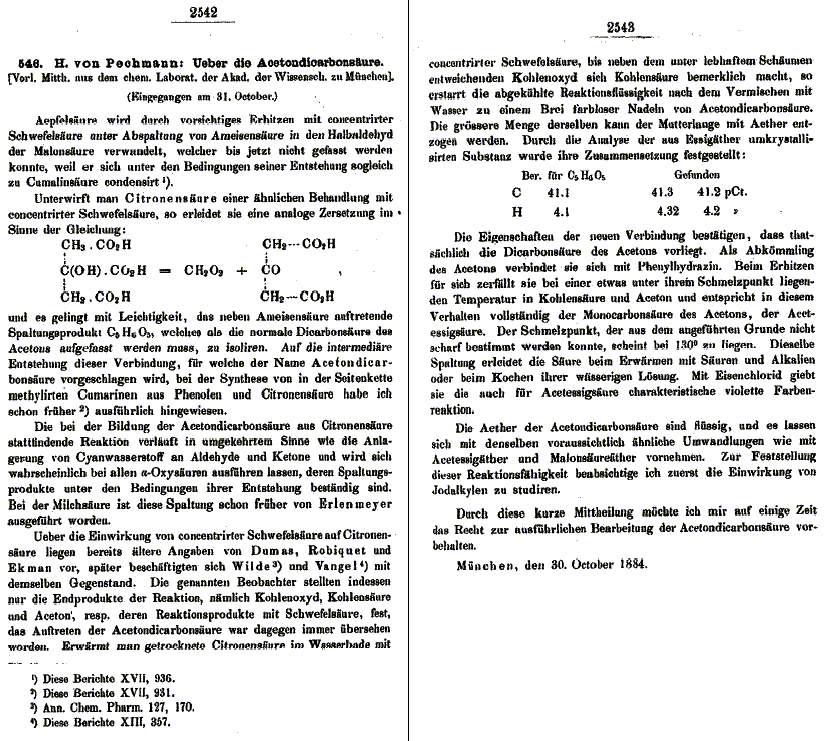12-11-03 18:48
No 476177
There are copious amounts of citric acid and concentrated sulfuric acid avail, but not fuming sulfuric acid. Being that making fuming slufuric acid is a very nasty process, I happened to note that the method described here for ketoglutaric acid http://www.orgsyn.org/orgsyn/prep.asp?pr
""3. Discussion
Acetonedicarboxylic acid can be prepared from citric acid by the action of concentrated2 or fuming sulfuric acid""
So anyone have any comments on why conc H2SO4 can also work? Also, in the Findlay's "Cocenrning 2-carbomethoxytropinone" it states that the dimethyl-b-ketoglutamate is formed in this reaction, yet Org Syn link says that the free acid is formed, which is it? Thanx!
(Chief Bee)
12-11-03 20:41
No 476209
Acetonedicarboxylic acid = Beta-ketoglutaric acid (not "b-ketoglutamate")
H2SO4 = Sulfuric Acid (not "slufuric acid")
Also, in the Findlay's "Cocenrning 2-carbomethoxytropinone" it states that the dimethyl-b-ketoglutamate is formed in this reaction, yet Org Syn link says that the free acid is formed, which is it?
Taken from Post 436988 (Rhodium: "Findlay's 2-carbomethoxytropinone synthesis", Serious Chemistry)
Dimethyl beta-ketoglutarate
Powdered, anhydrous citric acid (192 g., 1.00 mole), m.p. 153°, was added in 32-g. portions to fuming sulfuric acid (383 g., 202 ml., 21%) with stirring, the first two cautiously at 0° and the other four at 15-20° during 1.5 hrs. The mixture was stirred 1 hr. at 25°, 3 at 35°, and 17 at 25°. To the stirred, yellow mixture absolute methanol (500 ml.) was added dropwise at -5 to 0° (3 hrs.). The mixture was kept 13-20 hrs. at 25° and added to a stirred mixture of sodium bicarbonate (700 g.), ice (500 g.), and water (200 g.). The precipitated salts were immediately filtered off and washed with 50% aqueous methanol (150 ml.). The slightly alkaline yellow filtrates were extracted with ether (7x400 ml.), the extracts dried (Na2SO4), and the solvent removed on the water bath and then in vacuo. The residual oil, which contained some water, was distilled in vacuo [...]
Do you notice any procedural steps in Findlay's procedure which is not present in the procedure in Organic Syntheses?
The Hive - Clandestine Chemists Without Borders
(Hive Addict)
12-11-03 23:42
No 476245
(Rated as: good read)
Pechmann, Ber. 17, 2542-43 (1884)

Experimental part
Anhydrous citric acid is heated with concentrated sulfuric acid on a waterbath until besides the evolution of carbon monoxide a sudden vigorous evolution of carbon dioxide is noted. The reaction mixture is cooled and mixed with water, after which the mixture solidifies to a mass of colorless needles of acetonedicarboxylic acid. The larger quantity of acetonedicarboxylic acid can be extracted from the mother liquor with ether. Its composition was determined by the analysis of the recrystallised compound (from ethyl acetate).
The characteristics of the new compound do confirm the identity of acetonedicarboxylic acid. As a derivative of acetone it reacts with phenylhydrazine.
On heating it decomposes at a temperature somewhat below its melting point into carbon dioxyde and acetone and corresponds in this behavior completely to the monocarboxylic acid of acetone, acetoacetic acid. The melting point, which could not be determined for the aforementioned reason sharply, lies in the neighbourhood of 130°. When acetonedicarboxylic acid is heated with acids or alkalis, or in an aqueous solution, it undergoes the same decomposition. With ferric chloride it gives a violet color which is characteristic for acetoacetic acid.
The Other War (http://www.markfiore.com/animation/drug
(Hive Bee)
12-12-03 00:03
No 476246
Pechmann found 1884 small amounts of this acid by heating conc. H2SO4 with dried citric acid and said nothing about the yield.
Findlay pp are producing this acid with Oleum at about
-10° C
.
(Hive Addict)
12-12-03 00:22
No 476247
..but considering the cheapness and worldwide OTC availability of citric acid and sulfuric acid, even if the yield is really low, this still is a good alternative IMHO.
Maybe it would be a good idea to perform the procedure according to Findlay with conc. sulfuric acid to see what the yield is?
The Other War (http://www.markfiore.com/animation/drug
(Newbee)
12-12-03 02:13
No 476261
If infact, conc sulphuric can be used in Findlay's synth for the cyclic b-ketoglutarate product, this would be a tremendously powerful tool in 2-carbomethoxytropine chemistry. I don't see why it couldn't be used, since at the point where the methanol is added to the oleum/citric acid mixture, the oleum is most likely all converted to conc sulphuric acid by that time.
(Hive Bee)
12-12-03 11:34
No 476367
Pechmann takes dried citric acid and Findlay pp the monohydrate.
And I dont know what Pechmann 1884 means with conc. H2SO4, but I think it`s not the same like today.
roger2003
(Hive Bee)
12-16-03 23:18
No 477250
Sulfuric Acid.....
SWIM used this method and observed a yield of 87%
The product is stored at 0°C for weeks.
(Newbee)
12-17-03 17:26
No 477416
so did SWIM use standard conc H2SO4 right out of the bottle (not fumming?)
(Hive Bee)
12-17-03 20:53
No 477443
Yes i did.
The main problem in this reaction is the water in the citric acid and the temperature at which u work.
Use small flasks with dry-ice cooling. Make the citric acid waterfree by drying it in vacuu over sulfuric acid or P2O5 several days. Oleum isnt needed if the citric acid is waterfree. Keep the reaction as cold as u can.
good luck
preparative chemistry is a bitch